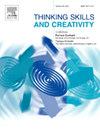Development of creativity in the first year of teaching studies: An intervention study
IF 4.5
2区 教育学
Q1 Social Sciences
引用次数: 0
Abstract
This study examines the effects of an intervention program aimed at fostering creativity in first-year students pursuing a degree in Early Childhood Education and Teaching in Primary Education (N = 181; 18.67 ± 1.41 years) in the context of a Spanish university by addressing socio-demographic aspects. A quasi-experimental design with a non-equivalent control group was employed, and creativity was assessed using the CREA test. The program was implemented over an academic year in three intervention groups, involving the utilization of various creative strategies applied to problem-solving in academic tasks. It spanned 14 weeks, with one 100-min session per week, in which ten activities were introduced. Results: The intervention program has achieved a significant development of creativity in all intervention groups, being especially relevant in one of them. The importance of sociodemographic variables, gender and age, was studied. Gender differences in creativity were not detected, neither in relation to age or academic performance of the students which suggest the need for further research in this direction. The results of the intervention program highlight the importance of teaching creativity for creative development in higher education by considering the creative learning and the characteristics of the students in order to adapt the interventions. The importance of implementing initiatives to foster creativity in university students is emphasized, highlighting the need for actions focused on teacher training and longitudinal studies to evaluate long-term effects. The research highlights the importance of creativity in higher education, showing significant improvements in the creativity of students in Early Childhood Education and in Teaching in Primary Education Degrees through specific interventions.
教学第一年创造力发展研究:一项干预研究
本研究考察了一项干预计划的效果,该计划旨在培养在西班牙一所大学攻读幼儿教育和小学教育教学学位的一年级学生(N = 181; 18.67±1.41岁)的创造力,涉及社会人口方面的问题。采用非等效对照组的准实验设计,并使用CREA测试评估创造力。该计划在三个干预小组中实施了一个学年,涉及使用各种创造性策略来解决学术任务中的问题。它持续了14周,每周进行一次100分钟的会议,其中介绍了10项活动。结果:干预方案在所有干预组中都取得了显著的创造力发展,其中一个干预组尤其相关。研究了社会人口变量,性别和年龄的重要性。创造力的性别差异没有被发现,也没有与学生的年龄或学习成绩有关,这表明需要在这个方向上进行进一步的研究。干预方案的结果强调了创造性教学对高等教育创造性发展的重要性,通过考虑创造性学习和学生的特点,以适应干预措施。会议强调了实施旨在培养大学生创造力的举措的重要性,强调需要采取行动,重点放在教师培训和纵向研究上,以评估长期效果。该研究强调了创造力在高等教育中的重要性,通过具体的干预措施,在幼儿教育和小学教育学位教学中,学生的创造力有了显著的提高。
本文章由计算机程序翻译,如有差异,请以英文原文为准。
求助全文
约1分钟内获得全文
求助全文
来源期刊

Thinking Skills and Creativity
EDUCATION & EDUCATIONAL RESEARCH-
CiteScore
6.40
自引率
16.20%
发文量
172
审稿时长
76 days
期刊介绍:
Thinking Skills and Creativity is a new journal providing a peer-reviewed forum for communication and debate for the community of researchers interested in teaching for thinking and creativity. Papers may represent a variety of theoretical perspectives and methodological approaches and may relate to any age level in a diversity of settings: formal and informal, education and work-based.
 求助内容:
求助内容: 应助结果提醒方式:
应助结果提醒方式:


